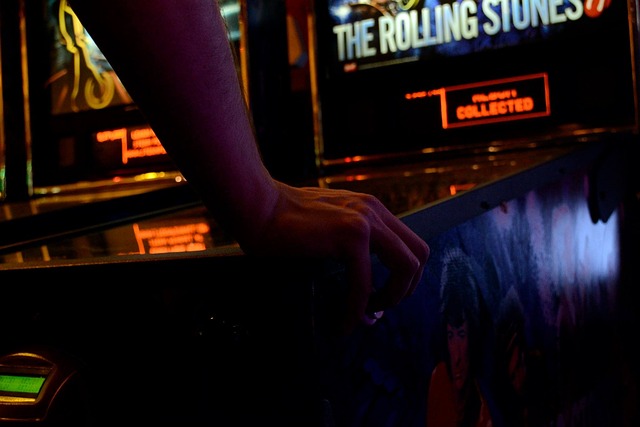Below is our definitive list of slang and technical terms related to arcade machines, encompassing terminology used in the design, operation, maintenance, and culture of arcade gaming. This includes hardware components, gameplay mechanics, and colloquial expressions from the arcade era (particularly the 1970s to 1990s) as well as modern arcade terminology. The list draws from the rich history of arcade culture, including terms from classic video arcades, pinball machines, redemption games, and related coin-operated entertainment
A
- Arcade: A venue or machine designed for coin-operated entertainment, typically housing video games, pinball machines, or redemption games. Originally referred to covered passageways with shops, later applied to gaming venues.
- Arcade Cabinet: The physical enclosure housing the game’s monitor, controls, internal hardware, and coin mechanisms. Available in upright, cocktail, or sit-down configurations.
- Attract Mode: A looping display of gameplay, title screens, or high scores shown when the machine is idle to entice players. Common in video games and pinball machines.
- Auto-Run: A mechanic in some arcade games where the player character moves forward automatically, requiring only directional or action inputs.
B
- Bezel: The border around the arcade cabinet’s monitor, often decorated with game-specific artwork or control instructions to enhance aesthetics and cover monitor edges.
- Bonus Stage: A special level in arcade games offering extra points or rewards, often with no risk of losing lives, e.g., car-smashing stage in Street Fighter II.
- Buff: To enhance a game element (e.g., character strength) via software updates or developer patches, often for balance. Originated in MMORPGs but applies to arcade game updates.
C
- Cab: Short for arcade cabinet, referring to the machine itself.
- Candy Cabinet: A standardized arcade cabinet, popular in Japan, designed for easy swapping of game boards, often using the JAMMA standard.
- Coin-Op: Short for “coin-operated,” describing machines requiring payment (coins or tokens) to play.
- Coin Drop: Slang for the coin slot or mechanism where players insert payment to start a game.
- Coin Mech: The mechanical or electronic device that accepts and validates coins or tokens, signaling the game board to start. Also called “coin slot.”
- Combo: A sequence of actions (e.g., button presses or moves) in fighting games to execute powerful attacks, e.g., Street Fighter’s Hadoken combos.
- Control Panel: The interface with input devices like joysticks, buttons, trackballs, or steering wheels, tailored to the game’s needs.
- Cooldown: A period after using an ability or weapon during which it cannot be used again, used to balance gameplay, e.g., rapid-fire limits in shooters.
- Cocktail Cabinet: A tabletop arcade machine where players sit, often with a flipping screen for two-player games. Common in the 1980s.
- CRT Monitor: Cathode Ray Tube display used in classic arcade machines for fast refresh rates and high contrast. Modern machines may use LCD/LED.
D
- Dip Switch: Small switches on an arcade machine’s circuit board used to configure settings like difficulty, lives, or coin requirements.
- Double Up: A gambling-style feature in some arcade games where players can wager winnings for a chance to double them, common in fruit machines.
E
- Electro-Mechanical Game: Arcade games using mechanical components alongside electronics, e.g., early pinball machines or shooting gallery games.
- Emulator: Software like MAME (Multiple Arcade Machine Emulator) that runs arcade games on modern hardware, often used in restored or custom cabinets.
- Extra Life: An additional attempt or “life” earned by reaching a score threshold or collecting an item, extending play without extra coins.
F
- Fruit Machine: A gambling arcade machine (common in the UK) with slot-like mechanics, often featuring fruit symbols.
- Free Play: A machine setting where no coins are required to play, often used in home arcades or during special events.
G
- Gibs: Visual effects showing body parts or debris after an enemy is defeated, often via explosions, e.g., in Narc or Doom.
- Gnarly: 1980s slang for something impressive or cool, e.g., “That high score is gnarly, dude!”
- Going Down: A warning that a player is losing their last visible lives, often when the game’s display can’t show all lives earned, e.g., in Robotron.
H
- High Score: The top recorded score on a machine, often displayed during attract mode or on a leaderboard. Players compete to “put their name” on it.
- Hitbox: The invisible area around a game object (e.g., character or projectile) that determines collision detection for hits or damage.
I
- Insta-Gib: An instant kill, often from teleporting onto an opponent (telefrag) or using a powerful weapon, e.g., rocket launcher in Narc.
- Insert Coin: The prompt displayed on-screen to start a game, synonymous with arcade culture.
J
- JAMMA: Japan Amusement Machine and Marketing Association standard for arcade wiring, allowing game boards to be swapped easily. Replaced by JVS for modern features.
- Joystick: A primary control device for moving characters or cursors, often paired with buttons for actions.
- JVS: JAMMA Video Standard, a modern arcade wiring standard supporting high-definition displays and network connectivity.
K
- Kill Screen: A game glitch or design limit causing unplayable levels or crashes at high scores, e.g., Pac-Man’s level 256.
- Knockdown: A term for defeating an enemy or boss in one hit, common in beat ‘em up games.
L
- LCD/LED Screen: Modern display screens replacing CRTs in newer arcade machines for energy efficiency and longevity.
- Light Gun: A gun-shaped controller used in shooting games like The House of the Dead, detecting screen position via light sensors.
M
- Marquee: A backlit sign or banner atop the cabinet displaying the game’s title, artwork, or logos to attract players.
- MAME: Multiple Arcade Machine Emulator, software for running classic arcade games on modern systems, popular among collectors.
- Merchandiser: A game where players win physical prizes via skill, e.g., claw cranes or coin pushers.
- Multicade: A modern arcade cabinet with an emulator running multiple classic games, often using MAME.
N
- Nerf: To weaken a game element (e.g., weapon or character) via software updates for balance, opposite of buff.
- Noisy: An arcade with all machines’ attract mode sounds turned on, creating a lively atmosphere. Opposite of “quiet.”
O
- One Credit Clear (1CC): Completing a game using only one coin, without continues. Also called “one-coin clear.”
- One Life Clear (1LC): Completing a game without losing a single life, a prestigious achievement.
- Operator: The person or company managing arcade machines, responsible for maintenance, coin collection, and settings.
P
- Pachinko: A Japanese mechanical game blending pinball and gambling elements, popular as both arcade and gambling machines.
- Pinball: A coin-op game with a slanted table, flippers, and a steel ball, where players score points by hitting targets.
- Pins: Slang for pinball machines, often used to describe arcades focused on pinball over video games.
- Player One/Player Two: Designations for the first and second players in multiplayer games, often shown on cocktail cabinets.
- Purikura: Japanese photo booth arcade machines that produce customizable selfie stickers, blending gaming and photography.
Q
- Quarter: The standard U.S. coin (25 cents) used in many arcade machines, synonymous with arcade culture.
- Quiet: An arcade with attract mode sounds turned off, creating a less chaotic environment.
R
- Rad: 1980s slang for “radical,” meaning excellent or impressive, e.g., “That new shooter is rad!”
- Redemption Game: A game where players earn tickets based on performance, redeemable for prizes, e.g., Skee-Ball.
- Resetter: An arcade operator who frequently resets high scores, common at seafront arcades, unlike city operators who may preserve scores.
- Rhythm Game: A genre requiring timed inputs to music, e.g., Dance Dance Revolution or BeatMania.
S
- Side Art: Decorative graphics on the sides of arcade cabinets, often featuring game characters or themes, e.g., Centipede’s iconic designs.
- Sprite: A 2D graphic representing a character or object in early arcade games, originally called “stamps” by Atari developers.
- Sweepstakes: Promotional contests on some arcade machines offering prizes based on skill or chance.
T
- Theorycrafting: Analyzing game data (e.g., damage per second) to optimize strategies, often in competitive arcade games like fighting games.
- Ticket Game: Another term for redemption games where players earn tickets for prizes.
- Trackball: A control device (e.g., a rolling ball) used in games like Centipede for precise cursor movement.
V
- Vidiot: A playful or derogatory term for someone obsessed with arcade games, common in the 1980s.
- Video Jones: Slang for a strong craving to play arcade games, e.g., “Got the video jones for Space Invaders.”
W
- Wireframe: Early 3D graphics in arcade games using simple line-based models, e.g., Battlezone (1980).
Notes
- Cultural Context: Many slang terms (e.g., “gnarly,” “rad”) reflect 1980s arcade culture, especially in the U.S. and UK.
- Game-Specific Terms: Some terms apply to specific genres, like “rhythm game” for Dance Dance Revolution or “light gun” for shooters.
- Modern vs. Classic: Terms like “MAME” and “multicade” reflect modern arcade preservation, while “quarter” and “vidiot” are tied to the classic era.
- Regional Variations: UK arcades use terms like “fruit machine” and “pins,” while Japanese arcades emphasize “pachinko” and “purikura.”

